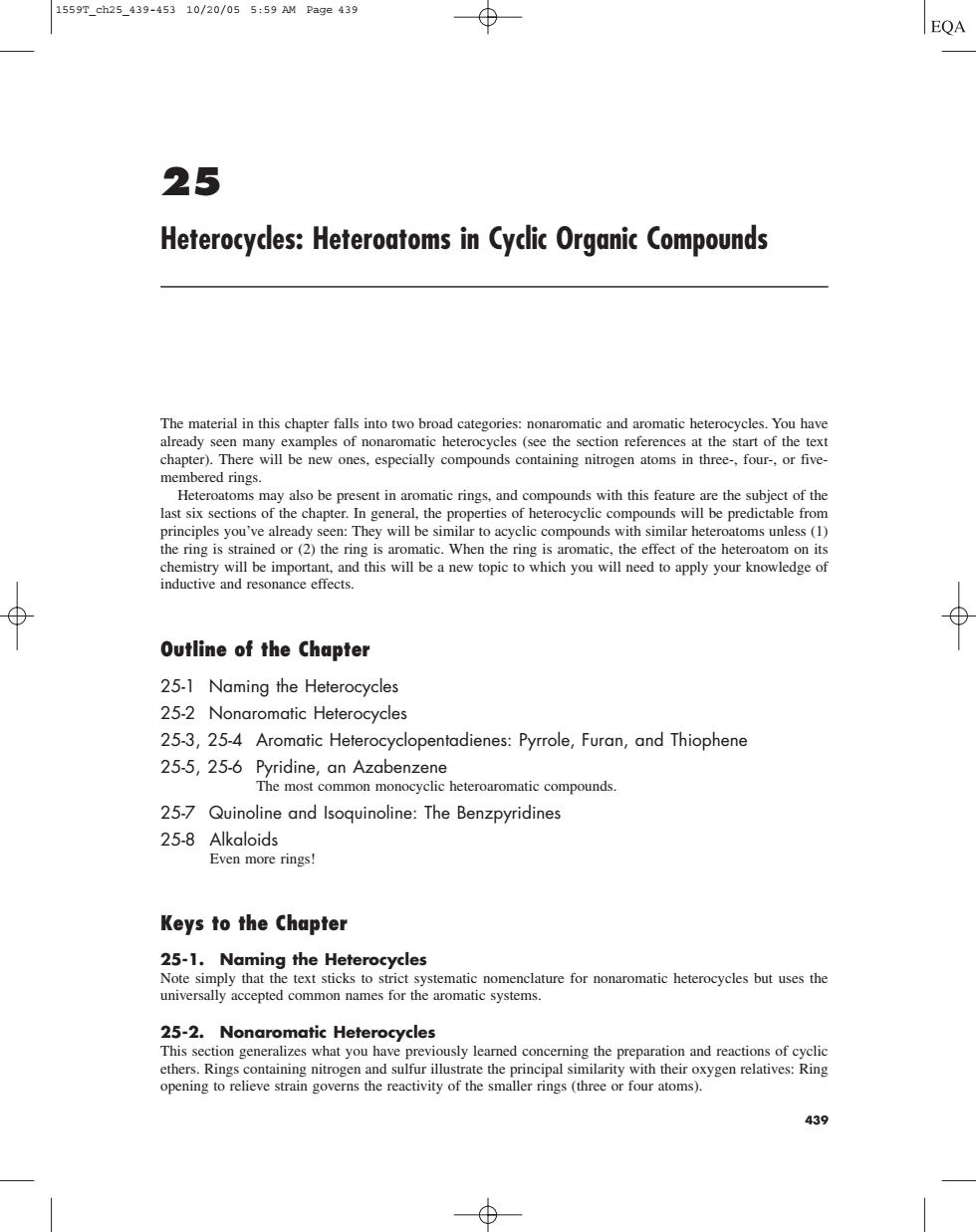正在加载图片...

1559T_Ch25_439-45310/20/055:59APa9e439 EQA 25 Heterocydes:Heteroatoms in Cycic Organic Compounds The material in this chapter falls into two broad cates matic and aromatic heterocyeles You have already seen many examples of nonaromatic hetero ycles (see the section references at the start of the text chapter).There will be new ones,especially compounds containing nitrogen atoms in three fourorfive Heteroatoms may also be present in aromatic rings,and compounds with this feature are the subject of the last six sections of the chapter.In general,the properties of heterocyclic compounds will be predictable from prnciples you've en:They will be s r to acyclic compoun tic. atoms unless (1 Outline of the Chapter 25-1 Naming the Heterocycles 25-2 Nonaromatic Heterocycles 25-3,25-4 Aromatic Heterocyclopentadienes:Pyrrole,Furan,and Thiophene 25-5,25-6 Pyridine,an Azabenzene The most common monocyclic heteroaromatic compounds. 25-7 Quinoline and Isoquinoline:The Benzpyridines 25-8 Alkaloids Even more rings! Keys to the Chapter 25-1.Naming the Het erocycles universally accepted common names for the aromatic systems. enclature for nonaromatic heterocycles but uses the 25-2.Nonaromatic Hete ocycles aae ontaining nitrogen and sulfur illustra 25 Heterocycles: Heteroatoms in Cyclic Organic Compounds The material in this chapter falls into two broad categories: nonaromatic and aromatic heterocycles. You have already seen many examples of nonaromatic heterocycles (see the section references at the start of the text chapter). There will be new ones, especially compounds containing nitrogen atoms in three-, four-, or fivemembered rings. Heteroatoms may also be present in aromatic rings, and compounds with this feature are the subject of the last six sections of the chapter. In general, the properties of heterocyclic compounds will be predictable from principles you’ve already seen: They will be similar to acyclic compounds with similar heteroatoms unless (1) the ring is strained or (2) the ring is aromatic. When the ring is aromatic, the effect of the heteroatom on its chemistry will be important, and this will be a new topic to which you will need to apply your knowledge of inductive and resonance effects. Outline of the Chapter 25-1 Naming the Heterocycles 25-2 Nonaromatic Heterocycles 25-3, 25-4 Aromatic Heterocyclopentadienes: Pyrrole, Furan, and Thiophene 25-5, 25-6 Pyridine, an Azabenzene The most common monocyclic heteroaromatic compounds. 25-7 Quinoline and Isoquinoline: The Benzpyridines 25-8 Alkaloids Even more rings! Keys to the Chapter 25-1. Naming the Heterocycles Note simply that the text sticks to strict systematic nomenclature for nonaromatic heterocycles but uses the universally accepted common names for the aromatic systems. 25-2. Nonaromatic Heterocycles This section generalizes what you have previously learned concerning the preparation and reactions of cyclic ethers. Rings containing nitrogen and sulfur illustrate the principal similarity with their oxygen relatives: Ring opening to relieve strain governs the reactivity of the smaller rings (three or four atoms). 439 1559T_ch25_439-453 10/20/05 5:59 AM Page 439